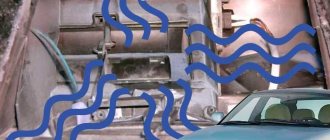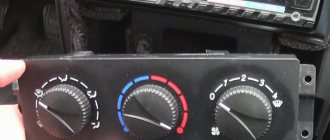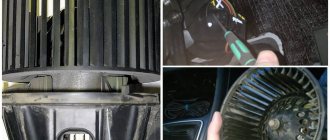Many owners of the 14th have encountered such an unpleasant situation as incorrect operation of the heater, which most often appears with the onset of the cold season. It is expressed in the fact that warm air does not blow on the windshield of the VAZ 2114, and sometimes instead of heat, cold air comes out of the working stove. Today we’ll talk about why such a malfunction may appear and how to fix it on your own.
Heater repair VAZ 2114
The device of the VAZ 2114 stove
Control lever (1), left heater shroud (2), footwell flap rod (3), radiator gasket (4), radiator (5), heater gasket (6), electric motor (7), fan shrouds (8), fan impeller (9), windshield heated flap (10), windshield heated air duct (11), side nozzle air duct (12), side nozzle (13), windshield heated flap rod (14), central nozzle (15) , foot heating flap (16), right heater casing (17), heater control handle (18), faucet control rod (19), heater control flap rod (20), windshield heated flap control knob (21), flap control knob foot heating (22), control lever bracket (23), heater casing mounting bracket (24), internal ventilation air duct (25), air supply window to the driver’s feet (26), heater control flap (27), foot heating flap handle ( 28).
Weak air flow
This reason arises due to the difficulty of air passing through the channels. This is influenced by several factors, which are detailed below.
Cabin filter
If the cabin filter is used for a long time, it may become clogged, which will lead to a decrease in air throughput and, consequently, to a weak air flow from the stove.
Stove motor
The VAZ 2114 uses a DC motor to pump air into the stoves, which can fail, which will lead to breakdown. It is also quite common that the engine cannot operate at full power due to insufficient voltage. To check, it is necessary to measure the voltage coming to the engine; it must be at least 12V.
Source
The stove blows cold air VAZ 2114, reasons
- The heater radiator is clogged or of poor quality.
- The heater motor does not work.
- The heater valve is faulty.
- There is an air lock in the engine cooling system.
- The cylinder head gasket is broken.
- Insufficient antifreeze level in the radiator.
- The heater control unit is faulty.
- The water pump does not provide the required circulation.
- Thermostat is faulty.
Causes of poor-quality stove operation
Based on the complex structure of the stove, it becomes clear that it may not work correctly for many reasons. A malfunction of at least one of the components and components of the heating system can lead to a malfunction of the stove. In this case, a malfunction may occur due to the driver’s fault, or it may be a consequence of aging or incorrect operation of other vehicle systems.
Problems with the stove can manifest themselves in the following ways:
- Poor interior heating.
- Cold air from the stove.
- Variable temperature of air supplied from the stove.
- Weak flow of hot air from the stove.
- The heater in the car does not turn on.
Knowledge of the structure of the stove itself and possible breakdowns will make it possible to avoid large expenses when repairing a car. Let's look at the most common causes of poor-quality stove operation below.
Fan doesn't work
A fan malfunction can often be one of the problems with heating the interior. The cause of this failure is usually damage to the bearings or graphite brushes, which may require complete fan replacement. Also, the fan may be faulty due to the blown fuse or relay in the electrical power circuit, which is also a reason to contact a car service center.
If the fan makes a whistle during operation, and its rotation speed changes from minimum to maximum and vice versa, then the cause of the problem may be a failure of the fan motor. In such conditions, the radiator may remain hot, but it will not be possible to warm the interior to the desired degree.
Insufficient coolant level
A malfunction of the stove can be caused by a coolant leak, as a result of which heat stops flowing into the cabin radiator in the required volume. This in turn leads to a decrease in the volume of antifreeze in the expansion tank. To fix the problem, you need to find the location of the leak, add antifreeze to the expansion tank, and sometimes it may be necessary to replace the coolant supply valve.
Engine pump faulty
The pump is used to circulate antifreeze and to ensure proper functioning of the stove. If such a pump breaks down, a malfunction may occur in many engine components, including the vehicle interior heating device.
A malfunction of this part can be caused by wear on the inside of the impeller, a broken crankshaft belt, or even jamming of the pump itself. It is better to eliminate this kind of problem by completely replacing the pump, and to avoid such breakdowns, it is recommended to regularly check the hose leading to the pump, and also listen to sounds under the hood.
Blown engine head gasket
The head gasket is designed to connect the block and the car engine head itself, ensuring tightness and preventing coolant and fuel from mixing with each other. Burnout of the gasket in the engine cooling jacket leads to the generation of exhaust gases, which can enter the cooling system through the pipes. In this case, the heat exchanger becomes airy and the efficiency of its operation decreases, the coolant can heat up, and malfunctions are observed in the operation of the stove.
Thermostat malfunction
The thermostat is a device directly involved in the circulation of coolant, so its malfunction will affect the air temperature in the cabin. Since the thermostat can be in an open or closed position, its failure is characterized by jamming in one of these positions.
If the thermostat is stuck in the closed position while driving in city traffic, the temperature of the antifreeze may increase, and subsequently the engine may overheat. When stuck open, the interior temperature will be low when driving in high gears, while the temperature will remain normal at low speeds.
Heater core blockage
The heater radiator can become clogged for various reasons, and this can happen both from the outside and from the inside. For example, the outside of the radiator may become clogged due to dust, leaves, and insects entering through the protective casing. On the inside, clogging occurs due to dirt and deposits that can form in the engine cooling system.
Attention! Poor quality antifreeze can also cause clogged radiator pipes.
Cabin filter clogged
A heavily contaminated cabin filter is one of the common causes of stove malfunctions. Many drivers treat it quite dismissively and do not replace or throw away the old one for a long time.
It should be remembered that a clogged filter is an obstacle to the flow of heated air into the cabin. In addition, when the filter is clogged, dust and mold spores can enter the cabin and accumulate in the filter itself.
Thermostat VAZ 2114 is faulty, how to fix it
If the thermostat is faulty, the antifreeze constantly circulates around the system, which is why it does not warm up, and the heater does not warm up or blows lukewarm air.
To solve the problem, you should check the condition of the thermostat and replace it if necessary.
Faulty stove faucet
Problems with the heater tap on VAZ 2108-15 cars occur quite often - if the tap is partially or completely closed, it does not allow hot antifreeze to enter the heater radiator. The problem with the heater tap is that it turns sour over time, and the damper in it stops moving. To prevent the valve in the faucet from turning sour, you must turn it at least once a week, moving it to the open and closed positions.
You can make sure that the faucet is letting warm air through by comparing the temperature of the pipes in the engine compartment and the passenger compartment - with the faucet fully open, the pipes should be equally hot. Changing a heater tap is quite troublesome, so for replacement you should buy original parts of good quality.
Thermostat air lock, how to remove
The problem may also be an air lock. It may appear if, after stopping the power unit while the antifreeze is cooling, air enters the upper section of the cooling radiator and then moves to the thermostat. When you next start the engine, air will enter the heater radiator using the water pump (at the same time, cold air will blow from the air ducts).
To remove the air lock, you should remove the pipe that goes into the heater, then add coolant to the top. The level of antifreeze in the system should be at least about or a centimeter above this mark. If there is a lack of fluid, the heater does not blow the warmest air.
Problems with the cooling system
When the heater on a VAZ-2114 does not work, reasons other than electrical may lie in the coolant circulation system:
- Air lock . As the coolant cools, air accumulates in the upper part of the radiator. Subsequently, air enters the thermostat and a large circle of coolant movement is blocked. The heater core remains cold. There are many ways to fix the problem. But the easiest thing is to squeeze out excess air from the system. To do this, unscrew the cap from the tank. With the engine running, the cold hose is intensely compressed, causing air to escape into the reservoir. If this method does not work, you will have to disconnect the hose to remove the air lock.
- Radiator . Few people devote time to maintaining their car, and especially the heating system. The internal space becomes clogged with dirt, which impedes the flow of coolant. The outer multi-cellular surface becomes clogged with dust and foreign objects, which interferes with heat transfer. In this case, only cleaning the radiator and replacing the cabin filter will help.
- Water pump . Wear of intake blades leads to a decrease in productivity and, consequently, a drop in pressure. Reduced idle pressure is unable to supply heated coolant to the radiator. Only high engine speeds allow you to create the necessary pressure.
- Low coolant level. An antifreeze level below the minimum provokes airing of pipelines. You just need to add antifreeze to the maximum level.
- Cylinder head gasket . A gradual decrease in coolant level, intense white smoke from the exhaust system and the smell of gasoline (oil) in the tank indicate a burnt-out gasket. Through the gap that appears, antifreeze enters the cylinders and into the crankcase with oil. Replacing the gasket requires removing a large number of parts.
- Thermostat . The operating principle of the thermostat is based on the property of a certain metal to change its original shape when the temperature rises. If the element fails, the coolant moves in a small circle without entering the heater radiator. In this case, only replacing the thermostat will help.
- Faucet. It regulates the flow of coolant, that is, the temperature inside the car. If it breaks, the fluid flow stops. Although it is held on by two screws, it is installed in a hard-to-reach place, under the dashboard, which is associated with certain difficulties.
- Hoses . Connecting rubber hoses become unusable after prolonged use. They crack and break. Through the formed cracks, the system depressurizes, and consequently, antifreeze leaks, air gets inside, etc.
Pump 2114 does not work, what should I do?
If the heater blows cold at idle, the cause may be a pump failure. The pump does not provide the required circulation of antifreeze in the system. Similar problems can be accompanied by a lack of antifreeze. When replacing the pump, you should pay attention to Belmag duralumin products.
Previously common HEPU pumps are often counterfeited, so it’s better not to buy them.
How to clear a blockage from the system?
The solution to the problem is quite simple. You should drive onto a hill with the front of the car. The higher the degree of elevation, the better. Next, with the engine running, unscrew the cap from the expansion tank and wait until all the air leaves the system. According to the laws of physics, air is lighter than liquid and tends to rise. This way we will create the most favorable conditions for this. Three to five minutes of engine operation is enough to completely remove the plug from the system. Periodically, you should rev up the gas up to 2-3 thousand revolutions in order to create more pressure for the coolant (the more the crankshaft rotates, the more often the pump rotates). It is also recommended to compress and unclench the air-filled pipe - this way we will speed up the process of oxygen coming out. But be careful - the temperature can reach 90 degrees. For safety reasons, cloth gloves should be worn.
The radiator is clogged, how to clean it
Sometimes the heater core becomes very clogged. The only solution in this case is to remove the spare part with further cleaning and purging, or replacement. As a rule, after this the stove heats up like new. Some drivers, when replacing a heater radiator, purchase Ukrainian-made products. Such radiators are characterized by low heat transfer to the interior, which is due to their design features. It is worth noting that experienced owners of VAZ cars advise buying only DAAZ brand radiators, since with them the stove heats better.
Step-by-step instructions for removing and installing the stove
The heat exchanger of the VAZ 2114 car is located in an extremely inconvenient place. Therefore, when removing and installing it, you will have to do a fairly large amount of disassembly and assembly operations.
The VAZ 2114 heater is equipped with air ducts, ventilation nozzles and levers for regulating the warm air flow
Tools and consumables
To work you will need the following tools:
- Phillips and slotted screwdrivers with short and long handles (screwdriver);
- set of wrenches;
- container and rubber hose for draining coolant;
- rags, a piece of oilcloth.
Procedure for replacement
In order to remove the heater radiator of a VAZ 2114 car, you should perform the following operations:
First, drain the antifreeze on a cold engine. Then unscrew the screw located behind the plastic plug.
Remove the glove compartment. First, unfasten and detach the bottom half. Then remove the cover along with the light bulb. Unscrew the screws securing the upper part and, with slight pressure and rotation, lower it down. In total, you will need to unscrew six screws.
Unscrew the two upper and two lower self-tapping screws securing the instrument panel.
Remove the lower protective cover from the steering column. To do this, remove three self-tapping screws and three screws from below.
Pull the plug out of the cigarette lighter socket.
Disconnect the connectors of the pads from the car radio and remove it from the slide.
On both sides, unscrew the screws securing the plastic console.
Pull out the flags that regulate the position of the damper and remove the heater fan mode switch.
Disconnect the console from the panel.
On the console, disconnect the terminals from the buttons for turning on the lights, heated rear window, fog lights, etc.
Be sure to mark them with a marker or notches in order of location.
Disconnect the console from the panel.
Disconnect the ashtray light connector.
Unscrew the two screws from the diagnostic connector and carefully completely disconnect the console.
Carefully remove the console and set it aside.
Unscrew the two screws securing the metal base to the floor - one on the left and the other on the right side of the bracket.
Unscrew the four self-tapping screws securing the front panel (“dashboard”) - two each to the left and right of the center of the console mounting.
First remove two large screws, then two smaller screws that secure the iron structure.
Pull the electronic control unit out from under the console.
To access the heating radiator, lift the left side of the dashboard using a jack.
In case antifreeze spills, place an oilcloth under the hoses and rags on it.
Unscrew the clamps from the hoses connecting the radiator to the engine cooling system.
Remove the rubber tubes from the heat exchanger pipes. Drain the coolant from the radiator into a prepared container.
Remove the heater core from its socket. Install the new radiator by performing all operations in reverse order.
To prevent an air lock from forming in the cooling system, remove the hose from the throttle body after loosening the clamp. Pour antifreeze into the expansion tank in a thin stream.
At the same time, watch the end of the disconnected hose - as soon as liquid flows from it, put it in place and tighten the clamp.
During the operation of a car, situations arise that any car enthusiast can resolve independently. Replacing a stove radiator is precisely this type of operation. As you can see from the article, doing this yourself is quite simple. The main thing is that after removing and installing the radiator, you do not have any unnecessary parts left, and all screws and clamps are tightly tightened. Good luck on the roads!
Cold air is blowing because the heater faucet 2114 is not working, how to fix it (step-by-step instructions)
It is not uncommon for a VAZ 2114 stove to refuse to work as a result of a faulty faucet. So, if your heater blows cold, you should try to tighten the special cable. You can get to it from the pedals. The cable must be grabbed with pliers and pulled slightly, increasing the tension. If the heater tap does not open even in this case, it is quite possible that it has become sour and should be replaced. You don't want to pull too hard or you could rip it off, causing coolant to leak into the cabin.
A faulty faucet means that the heater stops supplying hot air. The faucet also has to be changed if there are leaks. This entails the appearance of a greasy coating on the inner surfaces of car windows, the formation of wet spots on the floor, as well as the appearance of a characteristic smell of antifreeze or antifreeze in the cabin. If the leaks are severe, the carpet under the front passenger seat begins to get wet first, so experienced VAZ car owners recommend systematically inspecting this area.
The only way to correct the situation is by replacing the heater tap, for which you need to perform the following steps:
- Unscrew the drain plugs on the engine block and drain all the antifreeze.
- Clean the studs on the faucet with a wire brush and moisten them with WD-40, which will make unscrewing easier and prevent you from breaking anything. If the pin breaks, the repair will become much more difficult.
- We remove the clamps on the pipes, having first loosened them, and drain the remaining coolant.
- Next, you need to unscrew the side trim in the cabin and loosen the clamps on the pipes that go into the heater radiator. When you get here, the pipes can be replaced.
- Using a spanner, unscrew the nuts holding the faucet under the car.
- We pull the faucet into the elephant, disconnect the cable with the spring fastening, and then install a new faucet.
- We assemble all the elements.
Causes of malfunctions
In some cases, the fact that the furnace is blowing cold air is normal. For example, when you turn it on in ventilation mode. But if you switch to heating mode, but the heater is not going to blow hot air, you are faced with a breakdown.
Specialists at the service station will tell you that there can be many reasons for the breakdown. This is another reason to take more money. Therefore, it is in your interests and for reasons of economy to check each reason yourself. Besides, it's not that difficult. Among the main reasons why the stove on the VAZ-2114 stopped working and producing hot air may be:
- broken fan;
- airlock;
- stove tap;
- radiator;
- insufficient pressure;
- antifreeze deficiency;
- cylinder head gasket;
- motor.
As you can see, there are enough options for why the system stopped working.
We recommend: What to do if the VAZ-2112 16-valve engine fails
Important! If you decide to do the repairs yourself, start with the most likely and simplest reasons for the failure of the heating system. It is better to entrust complex stages in the absence of relevant experience to specialists.
Fan
Warm or hot air may not flow from the stove if the fan is not activated from the start. In this situation, you will have to completely disassemble the stove and look for the cause inside it.
To avoid unnecessary dismantling work, start the engine and turn on in turn all the power levels at which the fan operates. If there is no noise or any movement, then you will still have to disassemble the system and change the fan or its motor.
Important! The thermostat is another potential culprit when the heater does not want to turn on. A faulty thermostat causes the coolant to circulate, but does not have time to cool.
Airlock
Quite often, VAZ-2114 stoves do not heat well due to the fact that an air lock has formed inside the cooling system. It appears mainly in cases where the engine has already stopped working. From this moment on, the temperature of the coolant begins to drop. In such situations, air is able to leak into the upper part of your VAZ-2114 radiator, after which the plug penetrates the thermostat.
The next time you start the engine, the heater may not turn on. This is due to the fact that when the engine starts, the pump drives accumulated air through the thermostat into the heater radiator. In some cases, because of this, VAZ-2114 stoves only heat up at speed. Therefore, before sending the car to a service station, simply try to get rid of air in the system. Although there are other possible reasons for the lack of heat at idle and its appearance after pressing the gas. This is the heater valve or the same cylinder head gasket.
Important! There is a fairly simple way to get rid of an air lock. To do this, remove the pipe and gradually fill in antifreeze to the maximum level.
Faucet
As experts and VAZ-2114 owners themselves, who have encountered problems with the heating system, note, it is because of the faucet that hot air most often stops flowing.
It does not open completely, which leads to an uncomfortable temperature inside the car. Moreover, heat does not come out of the stove for two reasons related to the faucet:
- The element has completely stopped performing its functions, that is, it needs to be replaced with a new one.
- The fixation of the stove faucet is broken due to a loose cable. It is located in the pedal area. To adjust and restore tension, grab the element with pliers and try to tighten it.
Important! If there is no supply of hot air to the interior of the VAZ-2114, and at the same time there are leaks from the faucet, then it must be urgently and urgently replaced.
This can be determined by the greasy coating on the glass and greasy stains on the floor. You will also notice an unpleasant odor of antifreeze inside the cabin. In this situation, the heater will not be able to turn on.
Radiator
The heating system does not turn on or barely works if the radiator is clogged. As the car is used, the radiator becomes filled with dirt, dust and all kinds of debris. If you do not periodically engage in prevention, it will soon cease to function normally, and serious problems will arise. And not only with the heating system.
A clogged radiator means that warm air barely penetrates into the cabin. Therefore, the optimal solution is to clean the element.
It is much worse if the radiator fails and is not of the highest quality. Mostly, owners of newly purchased VAZ-2114 are faced with low-grade or simply outdated radiators. Few people immediately pay attention to the radiator.
The only option is to replace the radiator with a new and high-quality one. The replacement procedure is as follows:
- the front panel is disassembled and the console is removed;
- antifreeze (if you reuse it) is drained into a clean container through the drain hole or the radiator itself;
- the central panel, side elements and glove compartment are dismantled;
- remove all fasteners that hold the panel to the body;
- the cables are turned off and disconnected;
- the torpedo moves to the side;
- pipes are turned off;
- the old radiator is removed and a new one is installed in its place;
- If all dismantled elements are in good condition, they are returned to their place in the reverse order.
Pressure
There may simply not be enough pressure in the heating system. You will discover this by a characteristic sign - the stove cannot heat at idle. The pump, that is, the pump, is responsible for the pressure. It’s easy to find and eliminate the cause: when you drive, heat enters the cabin, and when you stop, the inside of the car becomes cold again.
The solution is to replace the pump. Moreover, experienced VAZ-2114 car owners advise using only aluminum pumps.
Antifreeze
When hot air does not want to come out of the stove, do not rush to look for the reasons inside and begin dismantling work. The problem may be hidden in an extremely simple phenomenon - a lack of antifreeze in the system.
So be sure to check what level the coolant is at and whether the VAZ-2114 is experiencing a coolant deficiency. Here, try to always follow simple rules:
- during summer and warm spring, the antifreeze level should always be at the max mark, but not below it;
- In winter, you need to fill in so much that there is more than 2 of your fingers relative to the maximum coolant mark.
Important! Many problems arise due to the fact that VAZ-2114 owners forget to periodically add coolant. Make it a habit to avoid unpleasant breakdowns.
Pad
The lack of warm air may be due to a blown cylinder head gasket. If you notice the signs, then there is only one thing left to do - change the gasket. Several characteristic signs indicate the fact of a burnt cylinder head gasket:
- the coolant smells like exhaust or gasoline;
- the motor oil has a characteristic aroma of antifreeze or antifreeze;
- Thick white smoke comes out through the muffler.
Stove motor
Another potential culprit for problems with heat inside the VAZ-2114. It breaks, partially fails or burns out completely.
Important! Don't make this common mistake. Before changing the motor, check that the relay is working properly and that the switches are working correctly.
If the cause is the motor, it will have to be replaced by dismantling the heating system and first draining the coolant. You can clearly see that the stove on a VAZ-2114 may not heat up for various reasons. Start step by step by eliminating from the simplest to the most complex.
Have you had any problems with the stove and what caused it to fail? Tell us about your cases in the comments and be sure to clarify how exactly you solved the problem. We will be very interested to discuss this with you.
VAZ 2114 heater fuse burned out, reasons
A blown fuse is one of the most annoying and simple faults. It’s simple because every motorist can replace a fuse, but it’s unpleasant because it can be very difficult to diagnose why it blew. Usually fuses blow as a result of a short circuit in the electrical wiring. On the VAZ 2114 the heater is controlled by the F7 30 ampere fuse. It also affects the cigarette lighter, heated rear window, electric headlight washer motor and glove compartment lighting. Accordingly, all these components will not work along with the heater.
Causes of malfunctions
In winter, when the cabin heater stops working, you feel discomfort: it is cold in the car and the windows freeze. To figure out why the stove on the VAZ-2114 does not work, the car should be driven into the garage.
Additionally, we recommend reading the article by our specialist, which describes how the on-board computer of the VAZ-2114 works.
Before starting work, you need to become familiar with the structure of the vehicle's heating system. The structure consists of the following elements:
- heater radiator;
- pipes supplying heated coolant;
- faucet that regulates the flow of liquid;
- interior dampers directing the air flow;
- a fan that creates air flow;
- fan speed controller;
- a pump that creates a flow of heated liquid;
- thermostat, which is responsible for the direction of movement of the coolant.
When all these elements function normally, the car interior is warm. But when one of them stops working, interruptions in heating occur.
If the fan of the VAZ-2114 heater does not work, the reasons most often given by auto mechanics are the following:
- fan failure;
- fuse blown;
- lack of contact in the electrical circuit;
- heater radiator malfunction;
- The thermostat does not respond to temperature changes;
- faucet breakdown;
- low pressure in the coolant circulation system;
- airlock;
- The engine cylinder head gasket was blown.
We recommend: How to change the oil filter without changing the oil?
We also recommend reading our expert’s article, which talks about how to change the heater radiator on a VAZ-2110.
Cold air is blowing due to a problem with the switch, how to check and fix the problem
To test the heater switch, you will need a simple 12-volt lamp with two wires. You should remove the central part of the dashboard and do the following:
- Turn on the ignition.
- We close the negative contact of the lamp to ground.
- Next, we alternately connect the positive contact to outputs 1, 2, 3 on the additional resistor.
The switch is considered operational if the lamp lights up. Otherwise, the problem may be an open circuit or a blown fuse. If only the third speed does not work, replace the additional resistor.
Heater motor malfunctions
Troubleshooting in the heating system of front-wheel drive VAZs should begin with the heater motor:
- turn on the ignition, start the engine;
- On the heater control unit we check the operation of the motor in all positions. If you can hear the stove motor changing speed when switching, it is most likely working.
The heater motor may not work for several reasons:
- the fuse responsible for the operation of the electric motor has blown;
- the contact in the mounting block has oxidized;
- the switch itself is faulty;
- there are breaks in the electrical wiring;
- The furnace electric motor burned out.
VAZ 2114 heater motor burned out, how to replace it
Over time, the heater motor may burn out, but before replacing it, you should check all fuses for integrity, as well as the ignition relay and heater temperature switch. If everything is fine with them, then the problem is in the motor. Replace it by first disassembling and dismantling the dashboard. It is also necessary to drain the antifreeze from the system and turn off the heater tap. Having removed all the pipes, we take out the old stove and install a new one.
Why does it blow cold on the windshield?
The supply of heated air in this location is regulated by a special damper. It is driven by a cable, which on a VAZ is generally stretched very often. This, in turn, leads to the fact that the damper itself does not open fully. In such a situation, air will be supplied inside the car directly from the street, that is, cold.
Understanding the principle by which heating functions in the VAZ-2114, it is generally not difficult to find out what the actual problem is. But even an experienced car enthusiast will need a lot of time to fix it. The thing is that the stove itself is located directly behind the panel located in the front of the cabin, near the steering wheel - troubleshooting requires its dismantling.
The problem with the cable is most noticeable when the temperature control is turned downward (that is, to the left).
Repairing heating in general is quite easy. You should proceed in this order:
- The cover under the steering wheel on the left is removed;
- the cable itself and its fastening are found near the gas pedal;
- the clamp is dismantled;
- the cable is tightened so that it does not sag;
- fixed with the same clamp;
- the damper control levers move (left to right all the way and vice versa);
- The tap regulator is set to maximum.
After this, the ignition is turned on and very soon fairly hot air begins to blow from the previously blocked holes. As practice shows, these manipulations help get rid of the problem in virtually all cases.
To eliminate this mess, you will need to remove the cable of the damper mentioned above from the heating regulator. This is done as follows:
- remove the cover on the right side of the steering column;
- the regulator drive is found there (it has 2 cables);
- the one to the right is unhooked;
- the dismantled cable is tensioned so that the damper moves to the position of maximum heating of the interior;
- the resulting excess piece is cut off after fixing it in the old place, with a margin of no more than one and a half centimeters.
After this, the stove should work fully, and adjusting the temperature will be easy and comfortable.
The most common causes of problems
Most often, the phenomenon in which cold air blows from the VAZ 2114 stove on the sides and onto the windshield is caused by one of the following reasons:
- The thermostat has failed;
- air got inside the cooling system;
- The heater regulator has broken or its cable has become loose.
In addition, in quite rare cases, the cause may be a failed (clogged or leaking) radiator - you should start troubleshooting the system by checking it.
To do this, you need to completely warm up the car engine and carefully touch the pipes leading to and from the heater - if they are all hot, then the heater is working and you should look for the cause elsewhere.
Check the functionality of the thermostat and replace it only if the heating system does not work completely. If warm air enters the cabin, but only locally, then the reason most likely lies in a faulty heater regulator.
This element can fail for several reasons:
- the sealing foam layer has collapsed;
- the foam has peeled off and moved;
- The damper is sagging due to the loosening of the control cable.
The first two malfunctions (as well as the methods for eliminating them) are quite elementary - just glue the foam rubber or replace it with a new one, but the third case should be examined in more detail.
The reason that the stove blows cold air from the sides on a VAZ 2114 when the damper is not tightly closed is its design.
The heater is designed in such a way that the side airflow channels begin right under the damper, and even if it is slightly displaced (literally a few millimeters), instead of warm air, cold air from the deflectors begins to blow, coming directly from the street.
To eliminate this malfunction, you will need to tighten the cable that regulates the position of the damper.
Heater maintenance
To ensure that the VAZ-2114 heater heats well in winter, carry out maintenance of the heater before the cold weather:
- Remove it from the car.
- Disassemble and clean.
- Check the functionality of the dampers, seal their ends with sealants.
- Seal the joints with sealant.
- Flush the radiator.
- After assembly, adjust the drive cables so that when moving the sliders, the valves and the tap become in their extreme positions.
These measures are enough for the heating system to function normally in winter, providing warmth to the car interior.
Finally, we note that the reasons for the poor operation of the stove were discussed above, but it still continues to function. But this unit also has breakdowns and then the stove fails and stops working completely. Such reasons include breakdown of the radiator, leaks at the joints of the pipes, fan malfunction (open circuit, exhausted motor life or burnout).











